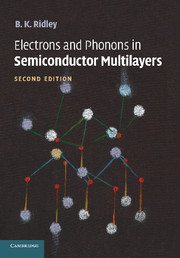Book contents
- Frontmatter
- Contents
- Preface
- Introduction
- 1 Simple Models of the Electron–Phonon Interaction
- 2 Quantum Confinement of Carriers
- 3 Quasi-Continuum Theory of Lattice Vibrations
- 4 Bulk Vibrational Modes in an Isotropic Continuum
- 5 Optical Modes in a Quantum Well
- 6 Superlattice Modes
- 7 Optical Modes in Various Structures
- 8 Electron–Optical Phonon Interaction in a Quantum Well
- 9 Other Scattering Mechanisms
- 10 Quantum Screening
- 11 The Electron Distribution Function
- 12 Spin Relaxation
- 13 Electrons and Phonons in the Wurtzite Lattice
- 14 Nitride Heterostructures
- 15 Terahertz Sources
- Appendix 1 The Polar-Optical Momentum-Relaxation Time in a 2D Degenerate Gas
- Appendix 2 Electron/Polar Optical Phonon Scattering Rates in a Spherical Cosine Band
- References
- Index
1 - Simple Models of the Electron–Phonon Interaction
Published online by Cambridge University Press: 05 September 2009
- Frontmatter
- Contents
- Preface
- Introduction
- 1 Simple Models of the Electron–Phonon Interaction
- 2 Quantum Confinement of Carriers
- 3 Quasi-Continuum Theory of Lattice Vibrations
- 4 Bulk Vibrational Modes in an Isotropic Continuum
- 5 Optical Modes in a Quantum Well
- 6 Superlattice Modes
- 7 Optical Modes in Various Structures
- 8 Electron–Optical Phonon Interaction in a Quantum Well
- 9 Other Scattering Mechanisms
- 10 Quantum Screening
- 11 The Electron Distribution Function
- 12 Spin Relaxation
- 13 Electrons and Phonons in the Wurtzite Lattice
- 14 Nitride Heterostructures
- 15 Terahertz Sources
- Appendix 1 The Polar-Optical Momentum-Relaxation Time in a 2D Degenerate Gas
- Appendix 2 Electron/Polar Optical Phonon Scattering Rates in a Spherical Cosine Band
- References
- Index
Summary
Teach us delight in simple things.
The Children's Song, R. KiplingGeneral Remarks
Evidently, the advent of mesoscopic layered semiconductor structures generated a need for a simple analytic description of the confinement of electrons and phonons within a layer and of how that confinement affected their mutual interaction. The difficulties encountered in the creation of a reliable description of excitations of one sort or another in layered material are familiar in many branches of physics. They are to do with boundary conditions. The usual treatment of electrons, phonons, plasmons, excitons, etc., in homogeneous bulk crystals simply breaks down when there is an interface separating materials with different properties. Attempts to fit bulk solutions across such an interface using simple, physically plausible connection rules are not always valid. How useful these rules are can be assessed only by an approach that obtains solutions of the relevant equations of motion in the presence of an interface, and there are two types of such an approach. One is to compute the microscopic band structure and lattice dynamics numerically; the other is to use a macroscopic model of longwavelength excitations spanning the interface. The latter is particularly appropriate for generating physical concepts of general applicability. Examples are the quasi-continuum approach of Kunin (1982) for elastic waves, the envelope-function method of Burt (1988) for electrons and the wavevector-space model of Chen and Nelson (1993) for electromagnetic waves and excitons.
- Type
- Chapter
- Information
- Electrons and Phonons in Semiconductor Multilayers , pp. 9 - 41Publisher: Cambridge University PressPrint publication year: 2009



